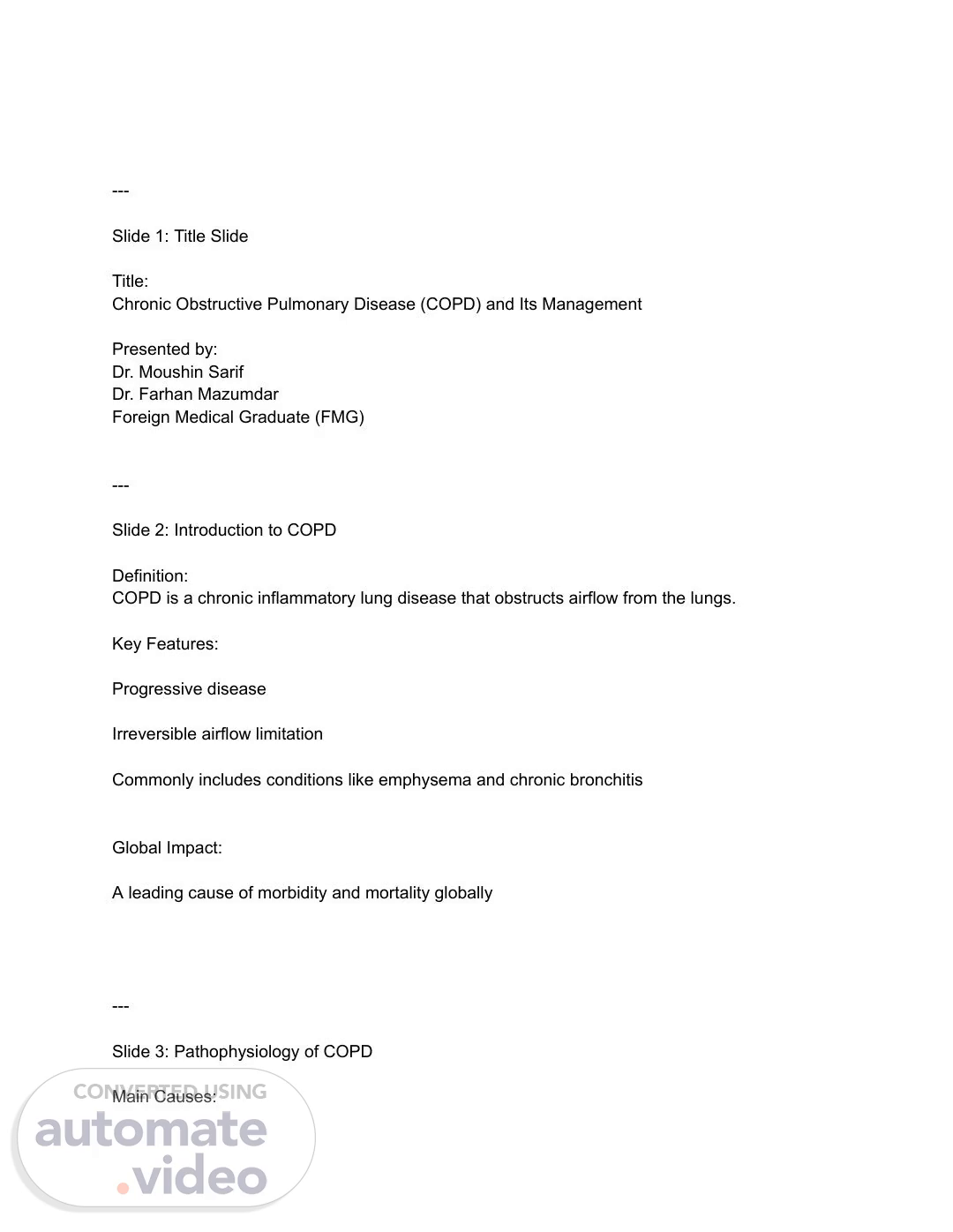Scene 1 (0s)
Slide 1: Title Slide Title: Chronic Obstructive Pulmonary Disease (COPD) and Its Management Presented by: Dr. Moushin Sarif Dr. Farhan Mazumdar Foreign Medical Graduate (FMG) Slide 2: Introduction to COPD Definition: COPD is a chronic inflammatory lung disease that obstructs airflow from the lungs. Key Features: Progressive disease Irreversible airflow limitation Commonly includes conditions like emphysema and chronic bronchitis Global Impact: A leading cause of morbidity and mortality globally Slide 3: Pathophysiology of COPD Main Causes:.
Scene 2 (20s)
Long-term exposure to irritants (smoking, pollutants) Genetic predisposition (e.g., alpha-1 antitrypsin deficiency) Pathophysiological Changes: Inflammation of the airways Destruction of alveoli Increased mucus production Air trapping and hyperinflation of lungs Slide 4: Risk Factors for COPD Primary Risk Factors: Tobacco smoke (primary and secondhand) Occupational exposure (dust, chemicals) Indoor air pollution (solid fuel burning) Age and sex (more common in older adults and men) Genetic factors (e.g., alpha-1 antitrypsin deficiency) Slide 5: Signs and Symptoms Common Symptoms:.
Scene 3 (42s)
Chronic cough Sputum production Dyspnea (shortness of breath), especially on exertion Wheezing and chest tightness Advanced Symptoms: Fatigue Unintended weight loss Frequent respiratory infections Slide 6: Diagnosis of COPD Spirometry Test: Confirms airflow obstruction with a reduced FEV1/FVC ratio (<0.70 post-bronchodilator). Additional Tests: Chest X-ray or CT scan (to rule out other conditions) Arterial blood gases (for severe cases) Six-minute walk test (functional status) Alpha-1 antitrypsin deficiency screening (for young patients or non-smokers) Slide 7: COPD Classification (GOLD Guidelines).
Scene 4 (1m 4s)
GOLD Staging Based on FEV1: GOLD 1 (Mild): FEV1 ≥ 80% predicted GOLD 2 (Moderate): FEV1 50-79% predicted GOLD 3 (Severe): FEV1 30-49% predicted GOLD 4 (Very Severe): FEV1 < 30% predicted Symptom and Exacerbation History: Assessed using CAT (COPD Assessment Test) or mMRC (Modified Medical Research Council Dyspnea Scale) Slide 8: Goals of COPD Management Primary Goals: Reduce symptoms Improve quality of life Prevent disease progression Reduce exacerbations and hospitalizations Improve exercise tolerance Slide 9: Pharmacological Management of COPD Bronchodilators:.
Scene 5 (1m 25s)
Short-acting beta2-agonists (SABA) and anticholinergics (SAMA) for immediate relief Long-acting beta2-agonists (LABA) and anticholinergics (LAMA) for maintenance therapy Inhaled Corticosteroids (ICS): Indicated for patients with frequent exacerbations Combination Therapy: LABA + LAMA or LABA + ICS for moderate to severe cases Other Medications: Phosphodiesterase-4 inhibitors (e.g., roflumilast) Mucolytics and antibiotics for managing exacerbations Slide 10: Non-Pharmacological Management of COPD Smoking Cessation: Most critical intervention for slowing disease progression Pulmonary Rehabilitation: Exercise training, nutritional counseling, and education Vaccinations: Influenza and pneumococcal vaccines to prevent respiratory infections Oxygen Therapy:.
Scene 6 (1m 50s)
For patients with chronic hypoxemia Surgical Options (in severe cases): Lung volume reduction surgery (LVRS) Lung transplantation Slide 11: Management of COPD Exacerbations Triggers: Respiratory infections, environmental pollutants, poor medication adherence Management Strategies: Increase bronchodilator use Short course of systemic corticosteroids (prednisolone) Antibiotics if bacterial infection is suspected Hospitalization for severe exacerbations (non-invasive ventilation or mechanical ventilation if necessary) Slide 12: Lifestyle Modifications and Self-Management Healthy Diet: Balanced nutrition to prevent weight loss and muscle wasting.
Scene 7 (2m 10s)
Physical Activity: Regular exercise to maintain lung function and overall fitness Self-Monitoring: Recognize early signs of exacerbations and act promptly Support Groups: Joining patient groups for mental health support and education Slide 13: Future Directions in COPD Management Emerging Treatments: Biologic therapies targeting inflammation Stem cell therapy and regenerative medicine Telemedicine: Remote monitoring of COPD symptoms and adherence Precision Medicine: Individualized treatment based on genetic, environmental, and lifestyle factors Slide 14: Conclusion.
Scene 8 (2m 31s)
Summary: COPD is a manageable but progressive condition Early detection, lifestyle changes, and appropriate pharmacological treatment can greatly improve patient outcomes. Patient education and self-management are key to long-term success. Thank you. 75 years of independence.
